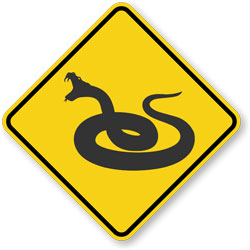
Caution: Snake photos below!
The alarm went off around 5:00 a.m. last Friday. It’s not an actual alarm; it’s just in my head. Go ahead and laugh; you’ll be old someday, too. I managed to stay in bed for another fifteen minutes, knowing that the coffee would be ready in the kitchen by then.
We normally are up at that time and heading out for a run around sunrise, but Friday was a “rest day” for us, so we decided to go for a walk before breakfast. It was the beginning of a day with some very interesting encounters.
But before heading out, I vacuumed up a small beetle that had managed to get inside the house. It was still alive and kicking, so I did what any good lizard wrangler would do: I took it to the garage and dropped it in the general vicinity of where Jim Morrison hangs out. Here’s what happened:
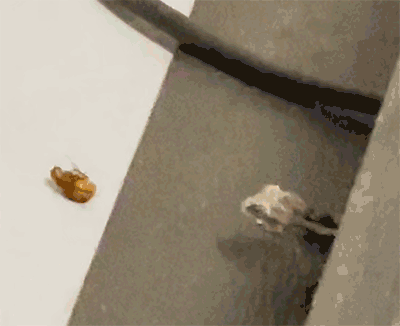
Jim Morrison, our Texas spiny lizard, enjoying a bite of breakfast
We left on our walk and were about a quarter mile into the trail that winds around our neighborhood when we spotted a gray fox ahead of us. It saw us about the same time and started running into the woods near the creek. But we hadn’t seen the second — and larger — fox until it suddenly took off in the same direction. We assume they are a mated pair.
We continued on our way around the trail, and eventually stopped to visit with neighbors who were walking their dogs (Abby and Drew Brees [yeah, they’re Saints fans…uh, the owners, not the dogs. I guess.]). They told us about a snake they had spotted the day before at an open house a couple of miles from our neighborhood, and she later sent me a photo.
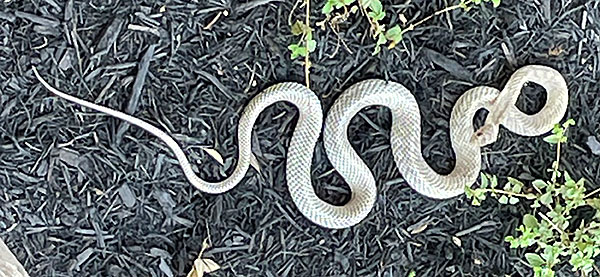
Western coachwhip (Masticophis flagellum testaceus — harmless; they’re not usually this light in color.
We walked down to the end of Creek Street, past where an earlier fire had burned down a section of fencing separating our neighborhood from another. A black vulture (referring to its color, yes, but that’s also the name of the species) was perched at the pinnacle of a burned-out mesquite tree. It was a scene that I couldn’t resist photographing.
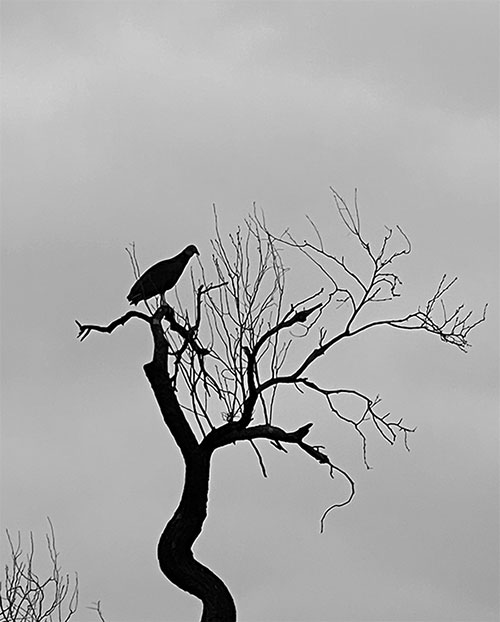
Black vulture (Coragyps atratus)
It’s relatively easy to distinguish a black vulture from the more common turkey vulture. The former has a black head, and the latter’s head is red. Also, the black vulture has a short tail, as you can see in the photo.
I could do an entire post on black vultures; they have some really interesting characteristics and behaviors that you might not expect…but we need to move along, so maybe later.
We completed the 3/4 mile circuit, and stopped briefly at the low water crossing where, as we’ve been anticipating, water was no longer crossing.
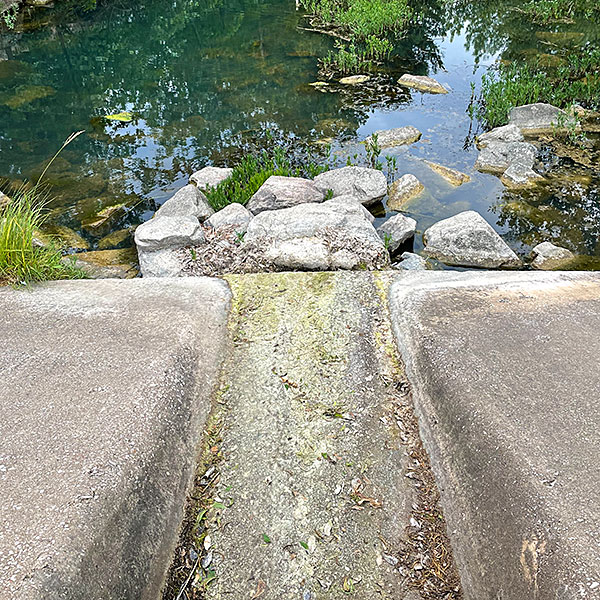
A sad sight, indeed.
It’s been a few years since Pecan Creek stopped flowing. We’ve got heavy rain in the forecast over the next few days, so we hope this is a very temporary situation.
We continued our walk through the neighborhood, along the main street that bisects it. We’d been hearing some different bird calls that appeared to originate ahead of us, but we had been focused on other things. It suddenly dawned on me: those are young or juvenile hawks!
Here’s a sample of what we were hearing:
There were at least two birds in different trees engaging in this “call and answer” behavior. As we walked toward a short cul-de-sac called Edwards Circle, we spotted one of them in a live oak:
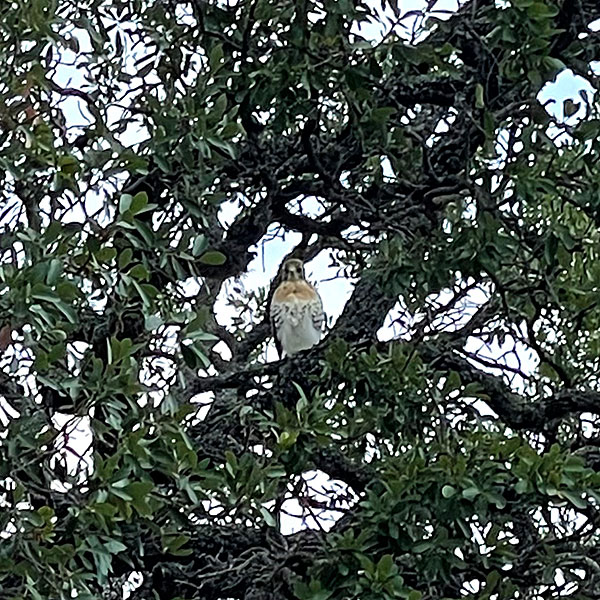
We think this is a juvenile red-tailed hawk.
At the next corner, we were able to make out a second young hawk high up in another live oak, but couldn’t get a good angle for a photo. It was also perched near a huge nest.
These observations were more interesting than usual to us because we had assumed that the nest had been abandoned. Almost a year ago, I reported on this nest; it had been home to a single nestling which disappeared after a storm. Based on some previous observations, we didn’t think the parents would return to this site, and as a result I had never bothered to check it out this spring. Our assumptions proved very wrong…stay tuned and we’ll talk about this some more in a moment.
I mentioned at the start that Friday was a “rest day” for us. I’m not sure how you define one, but it seems that for us, the only thing it means is that we don’t do any formal exercise. Instead, on this day at least, we bought 25 bags of mulch, which I loaded on the truck at Lowe’s and then unloaded at home, while Debbie spread it on the flowerbeds, all in 90º+ temperatures. We have a perverted definition of rest.
While I was unloading the mulch and dollying it to the back yard, I glanced over at a flower bed and spotted this:
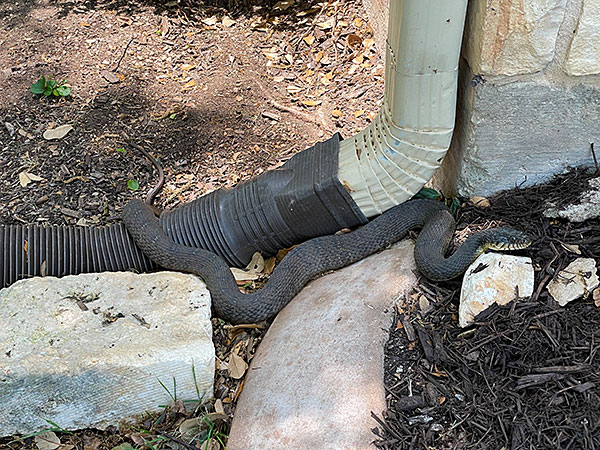
Plain-bellied water snake (Nerodia erythrogaster) — non-venomous
This harmless plain-bellied water snake (PBWS) had, for some unknowable reason, decided to slither up from the creek and spend some time in a newly-mulched flowerbed (another sweaty project from a couple of days earlier). It’s hard for me to accurately guess at the length of a snake, but it appeared to be between three and four feet long…a healthy specimen.
PBWSes get a bad rap as they are often mistaken for venomous cottonmouths (aka water moccasins), and thus are killed. The coloring and general body shape of the two species are somewhat similar, but it’s really very easy to tell them apart. The most obvious defining characteristics are on the head:
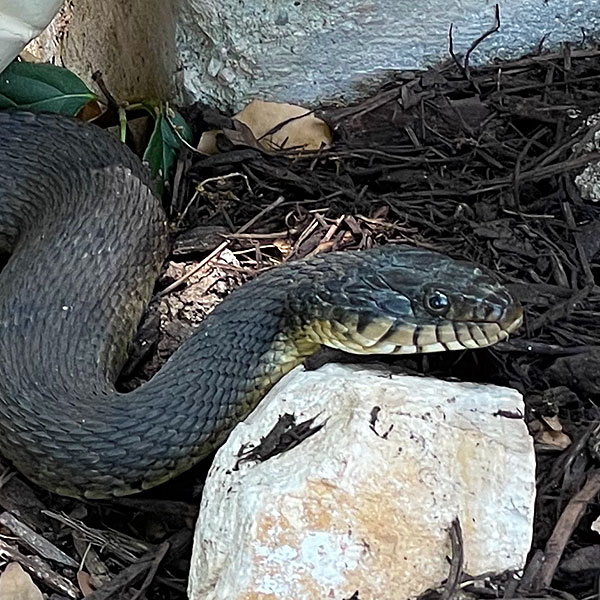
The slightly derpy look of a harmless water snake
If you were to look at this snake from above, you’d be able to see its eyes; a cottonmouth’s eyes are hooded. Also, the vertical stripes on the lower jaw are another defining characteristic of a PBWS. A cottonmouth, on the other hand, has a black “Zorro” mask running horizontally past its eyes and upper jaw.
Anyway, this fellow hung around for a while, despite my annoying attempts to photograph and video him. We assume that it was searching for frogs and toads that comprise its primary diet.
Now, I mentioned above that during our walk we encountered a couple of juvenile hawks in various trees. Now that I was aware that the nest was active, I decided to take my drone out after lunch and try to get some video footage and photos. Debbie accompanied me on the golf cart.
By then, it was very breezy and I wasn’t sure how successful my attempts would be. But I wasn’t at all prepared for what we encountered.
Two of the hawks were on the ground, and one of them was very obviously eating something. Both of them were fairly oblivious to our presence — I theorize that they weren’t old enough to have developed a healthy fear of humans, but perhaps we’re just not very threatening.
Anyway, we both took a bunch of photos with our phones, and then I launched the drone. I had a really difficult time seeing what the drone’s camera was focused on via my phone due to the bright sunlight, so it was a bit of sheer luck that I got a photo of the third sibling at the edge of the nest, which was about forty feet up in the tree.
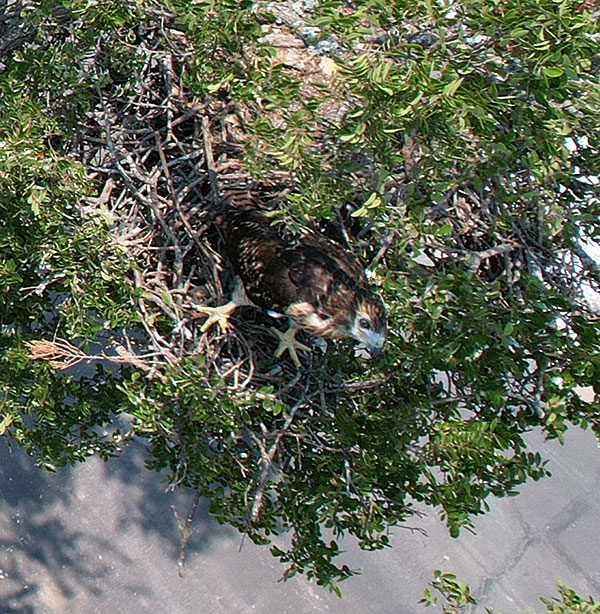
This juvenile red-tailed (we think) hawk didn’t join its siblings on the ground, for unknown reasons.
Back on the ground, the other two youngsters continued to be excellent photographic models. The one was laser-focused in its meal; the other appeared to be trying to stay cool by spreading its wings slightly.
Note that the following photos and video were taken via the drone. I was able to fly it within a few feet of the birds, and their only reactions were to occasionally glance at it. They never made any attempt to move away (or attack it, which I suppose might have been something a more mature bird would have done).
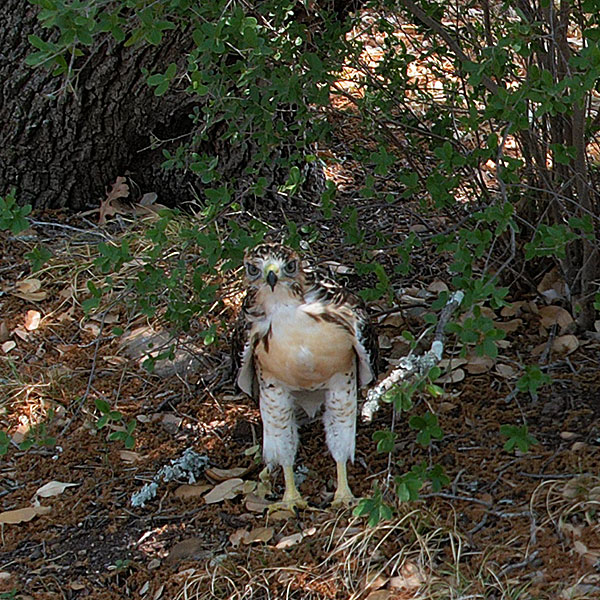
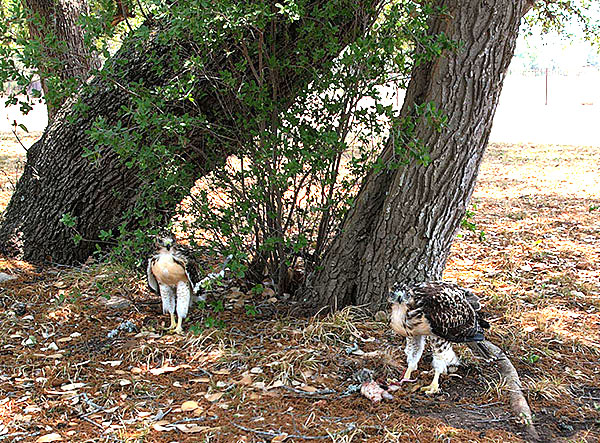
Here’s a short (47 second) video of the two hawks:
We eventually left the two youngsters to their own devices but returned a few hours later to see if we could tell what the one had been dining on. It was actually pretty interesting to look around at the base of the tree that housed the nest, and note the various skeletons and bits of fur and other body parts that gave clues about the youngsters’ diets.
And the mystery meal? It was a squirrel…and we’re happy to let them eat all of them they can catch!
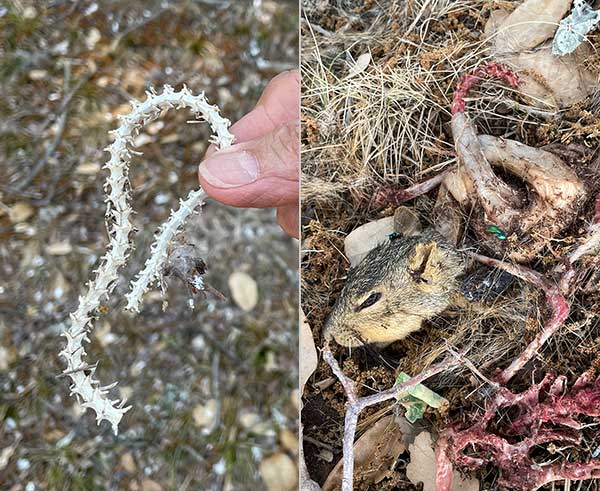
Snake skeleton on the left; squirrel remains on the right — both from victims of hawk predation (although I suspect ants actually picked the snake bones clean)
Not every day around here appears to be filled with such interesting nature encounters; I suspect there’s more going on than we know. But a little curiosity goes a long way in unraveling some of Nature’s secrets.
Discover more from The Fire Ant Gazette
Subscribe to get the latest posts sent to your email.


Awesome and quite interesting!!!
We love knowing and being aware of all these “critters” in our neighborhood!😃
That said, we appreciate all that you and Debbie do to keep us educated here in Pecan Creek.
Thanks, Diane…I’m glad you enjoy these little articles!